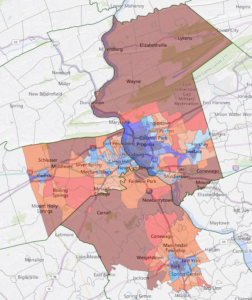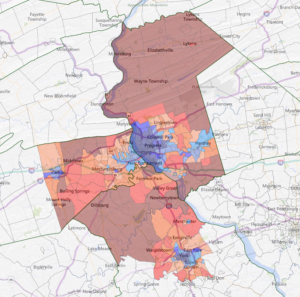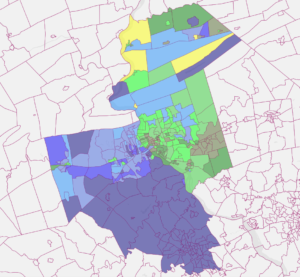As the 2020 election approached, Pennsylvania’s 10th Congressional District seemed to be on the verge of a transformation.
After all, the area was getting more and more progressive while being represented by an extremely conservative Congressman. As a result, prognosticators pegged PA-10 as the most flippable House seat in the state.
Despite all that, GOP incumbent Rep. Scott Perry ended up winning re-election over Democratic nominee and Auditor General Eugene DePasquale by a 53.3% to 46.7% margin.
This result is receiving renewed attention after The New York Times reported that Rep. Perry was a key figure in a plan to oust the Acting US Attorney General in support of former President Donald Trump’s efforts to overturn last year’s election result. This revelation is part of pattern reflecting Perry’s embrace of controversial and unfounded positions. Last October, for example, he was one of just 18 Congressmen to vote against a resolution to condemn Qanon. At roughly the same time, he asserted that the COVID-19 virus had been created in a Wuhan lab.
All this leads to questioning how Perry was able to win another term in a district thought to be a potential Democratic pickup. To answer that, we need to examine both the district and his opponent.
PA-10

2020 Congressional Results. Key: Navy – 65%+ DePasquale, Blue 60-64.9%, Royal Blue 55%-59.9%, Dodger Blue 50%-54.9%, Light Sky Blue <50%. Light Salmon <50% Perry, Coral 50%-54.9%, Orange Red 55%-59.9%, Red 60%-64.9%, Maroon 65%+. Ties are yellow. (All maps by Nick Field via Dave’s Redistricting)
Pennsylvania’s 10th Congressional District includes the entirety of Dauphin County, the eastern half of Cumberland County and the northern part of York County. Since it contains Harrisburg and its surrounding suburbs, many (including myself) were predicting that the district would turn blue in 2020. That turned out not to be the case.

2020 Presidential Results. Key: Navy – 65%+ Biden, Blue 60-64.9%, Royal Blue 55%-59.9%, Dodger Blue 50%-54.9%, Light Sky Blue <50%. Light Salmon <50% Trump, Coral 50%-54.9%, Orange Red 55%-59.9%, Red 60%-64.9%, Maroon 65%+. Ties are yellow. (All maps by Nick Field via Dave’s Redistricting)
Despite improving upon Hillary Clinton’s performance, Joe Biden still lost PA-10 to Donald Trump 47.6% to 50.6%. As you can see, Biden did outrun DePasquale in a few places like Camp Hill, Hershey and York. Nevertheless, while there were some split-ticket Biden-Perry voters, in this case they weren’t a decisive factor.
Geography instead was the more crucial component. The winning formula for Democrats is consistent everywhere: Run up the score in the cities, flip the suburbs and narrow your losses in the rural areas. Unfortunately for DePasquale, his problems were three-fold. He didn’t win Dauphin by enough (52.2%), didn’t flip Cumberland (44.7%) and got blown out in York (42.3%).
The issue with Cumberland may get solved over time, it made a large left-ward swing from 2016 to 2020. York is a much more difficult conundrum for Democrats, though, as it provided Donald Trump with a larger vote margin than any other county in 2020.
Eugene DePasquale
One reason this contest was so highly anticipated is that 2018 Democratic nominee George Scott, who was considered a fairly mediocre candidate, nearly pulled off an upset. The thinking went that if a newcomer like Scott was able to get so close, then a nominee who’d already won statewide office would be a favorite to win. In actuality, Scott out-performed DePasquale.

2018 Congressional Results. Key: Navy – 65%+ Scott, Blue 60-64.9%, Royal Blue 55%-59.9%, Dodger Blue 50%-54.9%, Light Sky Blue <50%. Light Salmon <50% Perry, Coral 50%-54.9%, Orange Red 55%-59.9%, Red 60%-64.9%, Maroon 65%+. Ties are yellow. (All maps by Nick Field via Dave’s Redistricting)
This raises the question of whether DePasquale was a poor candidate. His primary victory over Tom Brier was arguably underwhelming, as he won just 57.4% of the vote against a lesser-known first-time challenger. Examining the map from that primary contest, however, fails to provide a conclusive answer.

2020 Primary Results. Key: Navy – 65%+ DePasquale, Blue 60-64.9%, Royal Blue 55%-59.9%, Sky Blue 50%-54.9%. Lime 50%-54.9% Brier, Lime Green 55%-59.9%, Green 60%-64.9%, Dark Olive Green 65%+. Ties are yellow. (All maps by Nick Field via Dave’s Redistricting)
DePasquale’s worst area was Hershey, but that’s where his opponent was from. He disappointed in Dauphin, but dominated everywhere else. This duality even extended to November, when he lagged behind Biden in Harrisburg but outdid him around York. It’s also necessary to note that House Democrats did much better as a whole in 2018 than they did in 2020.
Looking Ahead
Given all this, we’re left with four possible conclusions. The first is that while the district is trending Democratic, its Republican roots were too strong and may take some time to overcome. Secondly, it could’ve just been a poor cycle for DePasquale and House Democratic candidates as a whole.
The third possibility is that most voters viewed Perry as a generic Republican and not as an aberrant public official. The increased scrutiny he’ll face for his efforts to overturn the election could alienate enough constituents to cost him his office.
Finally, there is the prospect that I was wrong. Perhaps Scott Perry is a good match for his district, and it is merely trending from a solid Republican seat to a likely Republican one.
Thanks to the upcoming round of redistricting, we’ll never know the true answer. With PA set to lose a seat, it’s unclear what the 10th district will look like two years from now. The slightest shift of the lines could make all the difference in what is sure to be a fierce electoral battleground in 2022.